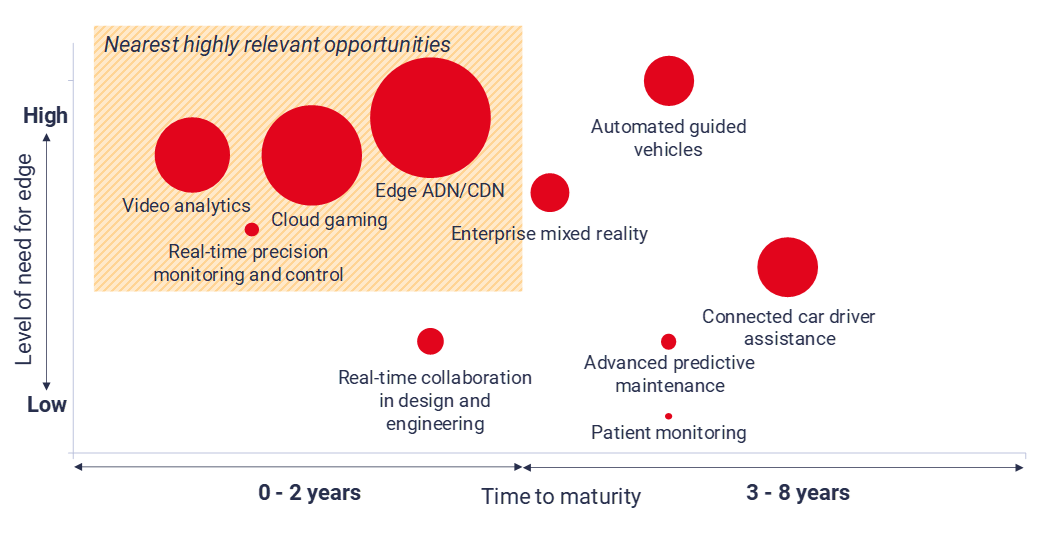Multi-access edge compute (MEC) is primarily about low latency.
The core concept of MEC is very straightforward: lowering the latency to deliver faster service to the end users. More often than not, MEC-related discussions circle around low latency of the network (by bringing network gears closer to the end users) and low latency of computation (by introducing accelerators such as GPU, FPGA or special ASICs).
Still, there is a third dimension that usually doesn’t get as much attention: lowering the latency of data processing at the edge.
End-users really don’t care about the source of latency. All they care about is how much time it takes for a service to be delivered to the requesting end point i.e. the end-to-end latency. It’s immaterial to them whether the latency is contributed by access network distance, by computation or by processing of data.
As for suppliers? Well, a key value proposition for Verizon adopting AWS Wavelength is ensuring a consistently low latency to the application developers as they serve new use cases for end users from the edge of the telco network. And, low latency data processing becomes extremely relevant for edge-use cases that are “data-heavy.”
That’s why we consider MEC a “sweet spot” for Aerospike. We offer not only real-time at scale consistent performance, but also the smallest footprint (and subsequently the lowest TCO) at edge, thanks to our patent-winning Hybrid Memory Architecture (HMA).
MEC market optimism
The global MEC market is exploding and no telco can afford to ignore it. Consider that Grand View Research reports that the CAGR for it is expected to be more than 42% from 2021 to 2028. This robust growth is attributed to the increasing use of IoT devices across various industries, and the need for faster decision-making in industries such as IT and telecom, manufacturing, transportation and logistics and datacenters. The research group also reports that the adoption of MEC offers a “safer environment for data transfer and reduces latency.”
STL Partners echoes similar optimism around the MEC market – in their estimates, total addressable market (TAM) for edge was worth only $10 billion in 2020, but is going to explode to $534 billion in 2030.
The universal consensus is that telco edge/MEC is an opportunity for telcos. This is an avenue for them to move up the value chain beyond connectivity and capture revenues from edge platforms and more important, applications i.e. use cases.
Use Cases and the Aerospike difference
According to STL Partners’ estimate, by 2030, 70% of the addressable revenue for edge should come from the applications with 21% from the edge infrastructure/platform/integration/managed services. Only 9% will go to pure connectivity. Their categorization of MEC use cases is as follows:

Source: STL Partners – Edge computing market sizing forecast
We have a similar view in the sense that in the near term, data-heavy edge use cases such as cloud gaming, video analytics and edge CDNs will dominate the conversation. There also should be an array of connected machine/sensor/device applications under the umbrella of IoT use cases.
Let’s delve into those use cases below with an emphasis on what Aerospike’s real-time data platform brings to the table:
Multiplayer cloud gaming. As gaming is emerging as the dominant non-streaming killer app for consumer broadband, the need for dynamic, interactive, multiplayer gaming is on an exponential rise. To provide a true real-time experience to the gamers, it requires processing lots of data. It also must extract insights out of that data and act on that data in a short amount of time. This all happens while the gamers are still engaged with whatever end devices they are using.
Hence comes MEC to the rescue. As highlighted by the Cox Edge gaming use case, by default the states of all entities related to a particular game need to be stored at edge locations closest to the end users. This is to enable extreme performance and dynamic gaming engagement in virtual worlds that are very large in size (up to tens of thousands of players/game) and have a huge number of complex AI and gameplay behaviors. Aerospike’s real-time data platform adds value for everyone involved. For the gamers, it’s a more engaging and fulfilling experience. For the providers, it’s an opportunity to keep the platform stickier with potential revenue upsides through cross-sell and upsell.Image/video analytics. Image/video analytics is a near-term edge use case that is already happening. The key value proposition here is very simple. First, the huge amount of image/video data that’s captured 24/7 by a range of edge devices/processes, does not need to travel in its entirety to the core network. It is much more efficient to process that data near to where it’s captured and only forward relevant filtered data to core, saving a ton on bandwidth cost along the way.
Second, a subset of this analytics use case – namely facial/object recognition – maintains its relevance/efficiency only if the decision can be rendered in real-time. Here comes MEC again with its low latency value proposition. Earlier in a blog post, I wrote about a Silicon Valley-based AI company that uses Aerospike data platform to power their facial recognition solution for a banking industry client. Anyone walking into a branch of that bank undergoes facial recognition at the entrance to verify identity and subscription tier. Our data platform plays a key role by not only storing the metadata of the contour of human faces, but also by supplying that data to the AI module in real-time to facilitate a fast and seamless decision. As MEC becomes more mainstream, we expect to see an explosion of this kind of use cases.Content management at edge. As claimed in the Cox Edge dynamic content delivery use case, by moving data and query to the edge, complex application functions such as authentication, content personalization, search, customization, and ordering can be done 10X-50X faster than with conventional application backends or content systems. The ability to work with any data model and turn that into an API that can then be integrated with web pages/applications/microservices is a key attribute of dynamic content delivery. When the content delivery happens from a backend centralized database/storage – even with CDN caching on – dynamic data requests need to travel long distances, adding latency in the process. This invariably deteriorates user experience.
Another aspect of content management is a high performance metadata store. The high performance can come from flexible schema, ability to support low latency read/write operations at massive scale, high uptime (>99.999%), and capabilities around replication, elastic search, secondary index, and expression filters etc., all supported by Aerospike.Internet of Things (IoT) at any scale. IoT use cases generally require time series capabilities. Although Aerospike originated as a key value store database, it now supports time series data models through Aerospike Time Series API and a combination of buffered writes and efficient map operations that allows us to optimize for both read and write of time series data.
To process IoT sensor data at the edge, the requirements include cleansing/filtering, formatting, ingesting, combining and transforming massive volumes of data. Then there is the requirement of real-time analysis to make sense of the data gathered. Finally, it needs to facilitate the generation of actionable insights leading into use cases such as precision control or predictive maintenance that benefit by being served from the edge (closer to the sensors/end points).
The key here is to take advantage of MEC’s low latency value proposition and not require the data to be backhauled all the way to the cloud. However, along with processing at edge, the ability to replicate and gather that data into a core system of record (SoR) can facilitate additional use cases (e.g. complex AI/ML related tasks) as discussed under the multi-player cloud gaming use case above.
Today, there is strong momentum behind MEC, driven by consumer and supplier demands for low and consistent latency. The four use cases that we highlighted above are just a snapshot of what new use cases are gaining traction. But, there can be many more. If you are exploring the space, Aerospike can work with you to generate both the architectural blueprint and business case. Read more about our Multi-access Edge Computing (MEC) Use Cases for greater details on how we do what we do. We firmly believe that MEC will continue to be a dominant topic within the telco ecosystem for the foreseeable future.




